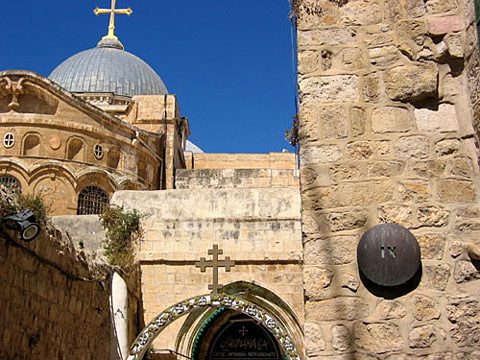
Via Dolorosa
Via Dolorosa (Latin for “Sorrowful Way” or “Way of Suffering”) is a route through the Old City of Jerusalem that is believed to be the path Jesus walked to his crucifixion. The route goes from Antonia Fortress to the Church of the Holy Sepulchre, a distance of about 600 meters, and is a celebrated place of Christian pilgrimage. The route was established in the 18th century. Today it is marked by the 14 Stations of the Cross, the final five stations of which are located inside the Church of the Holy Sepulchre. Station nine commemorates “Jesus Falls for the Third Time.” Located on the roof of the Church of the Holy Sepulchre.
Via Dolorosa (Latin for “Sorrowful Way” or “Way of Suffering”) is a route through the Old City of Jerusalem that is believed to be the path Jesus walked to his crucifixion. The route goes from Antonia Fortress to the Church of the Holy Sepulchre, a distance of about 600 meters, and is a celebrated place of Christian pilgrimage. The route was established in the 18th century. Today it is marked by the 14 Stations of the Cross, the final five stations of which are located inside the Church of the Holy Sepulchre. Station nine commemorates “Jesus Falls for the Third Time.” Located on the roof of the Church of the Holy Sepulchre.
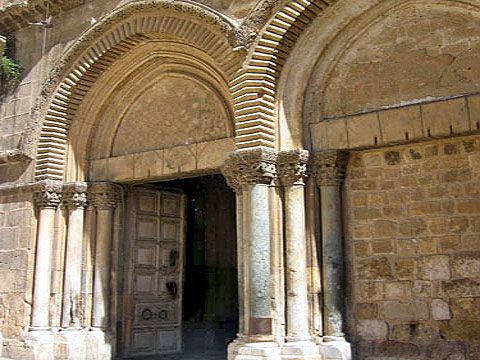
Church of the Holy Sepulchre
The Church of the Holy Sepulchre is one of the world’s holiest Christian landmarks, the site where Jesus was crucified, known as Calvary, and the tomb where Jesus was buried and then resurrected. Today, the tomb is enclosed by a shrine called the Aedicula. The final four Stations of the Cross, or Via Dolorosa, are also located inside the church. The wooden doors of the church’s main entrance are still the original doors from 326 CE. This puts into perspective the ancient grandeur of this holy church that is a pilgrimage center for Christians all over the world.
The Church of the Holy Sepulchre is one of the world’s holiest Christian landmarks, the site where Jesus was crucified, known as Calvary, and the tomb where Jesus was buried and then resurrected. Today, the tomb is enclosed by a shrine called the Aedicula. The final four Stations of the Cross, or Via Dolorosa, are also located inside the church. The wooden doors of the church’s main entrance are still the original doors from 326 CE. This puts into perspective the ancient grandeur of this holy church that is a pilgrimage center for Christians all over the world.
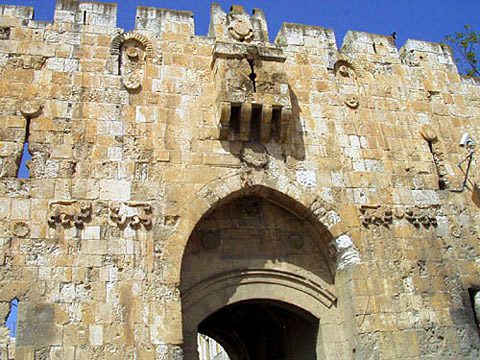
Lions Gate
One of the seven gates of the Old City, and the only one that is open towards the east. The gate was built during the 16th century by the Ottoman Sultan Suleiman the Magnificent. On both sides of the gate there are lion embossments. According to the legend, they were integrated into this structure following the dream of Sultan Suleiman, in which two lions were about to devour him, as a punishment for the situation of the holy city of Jerusalem, which was not protected at the time.
In Arabic it is named ‘’Bab al-Asbat” meaning Gate of the Tribes. The Christians named the gate “Stephen’s Gate” after the first Martyr, the first tortured saint who died for his faith in Jesus. According to one of the traditions, Stephen was stoned next to this gate. On Sunday of the first week prior to Easter, the Christians walk the path of Jesus, starting from the Mount of Olives. This is the “Palm Sunday”, in which processions of the faithful march from Mount Olives and continue via the Lion’s Gate to the Old City.
One of the seven gates of the Old City, and the only one that is open towards the east. The gate was built during the 16th century by the Ottoman Sultan Suleiman the Magnificent. On both sides of the gate there are lion embossments. According to the legend, they were integrated into this structure following the dream of Sultan Suleiman, in which two lions were about to devour him, as a punishment for the situation of the holy city of Jerusalem, which was not protected at the time.
In Arabic it is named ‘’Bab al-Asbat” meaning Gate of the Tribes. The Christians named the gate “Stephen’s Gate” after the first Martyr, the first tortured saint who died for his faith in Jesus. According to one of the traditions, Stephen was stoned next to this gate. On Sunday of the first week prior to Easter, the Christians walk the path of Jesus, starting from the Mount of Olives. This is the “Palm Sunday”, in which processions of the faithful march from Mount Olives and continue via the Lion’s Gate to the Old City.
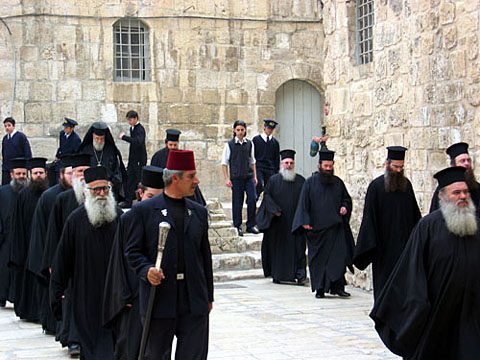
Outside the Holy Sepulcher Church
The Church of the Holy Sepulchre is located in the Christian Quarter of the Old City in Jerusalem. Ownership of the Church is shared and divided between the Greek Orthodox, Armenian Orthodox and Catholics. The majority of the Church and its chapels are open to the public.
The Church of the Holy Sepulchre is located in the Christian Quarter of the Old City in Jerusalem. Ownership of the Church is shared and divided between the Greek Orthodox, Armenian Orthodox and Catholics. The majority of the Church and its chapels are open to the public.
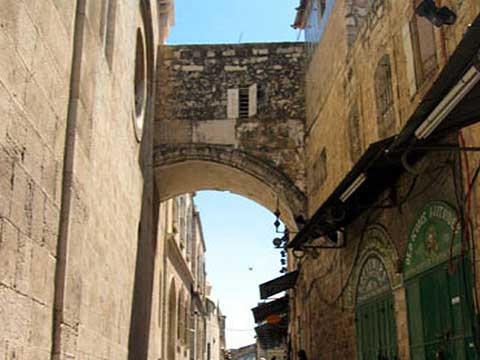
Ecce Homo Arch
The Ecce Homo Arch is an impressive arch made of stone, built above the Via Dolorosa Street.This ancient arch is known as Ecce Homo, which means in Latin “This is the man”. According to the New Testament (John 19-15), these were the words of the Roman governor Pontius Pilate, when he presented Jesus to the crowd, before sentencing him to death. In the past, many believed that this arch was once part of an ancient arch in the Antonia Fortress where Jesus was sentenced, and under this arch the Roman governor announced: “This is the man”, which is the reason for the arch’s name. But in fact, the arch was built after the times of Jesus. It was built during the 2nd century AD, the era of the emperor Hadrian, and was part of the Roman victory gate, which was the entrance gate to the “Forum” (a public courtyard). It was a gate with 3 arches.
The Ecce Homo Arch is an impressive arch made of stone, built above the Via Dolorosa Street.This ancient arch is known as Ecce Homo, which means in Latin “This is the man”. According to the New Testament (John 19-15), these were the words of the Roman governor Pontius Pilate, when he presented Jesus to the crowd, before sentencing him to death. In the past, many believed that this arch was once part of an ancient arch in the Antonia Fortress where Jesus was sentenced, and under this arch the Roman governor announced: “This is the man”, which is the reason for the arch’s name. But in fact, the arch was built after the times of Jesus. It was built during the 2nd century AD, the era of the emperor Hadrian, and was part of the Roman victory gate, which was the entrance gate to the “Forum” (a public courtyard). It was a gate with 3 arches.
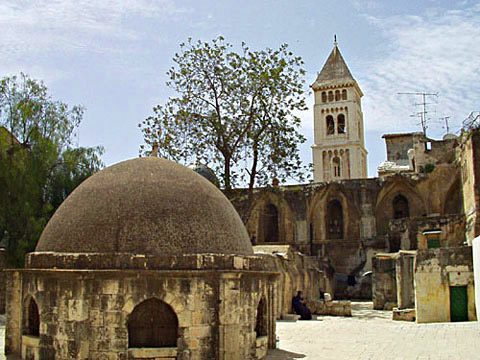
Ethiopian Monastery
Sequestered on the rooftop of the Church of the Holy Sepulchre, this monastery houses a few monks from the Church of Ethiopia who live among the ruins of a medieval cloister erected by the Crusaders. The cupola in the middle of the roof section admits light to St Helena’s crypt below. A door in the southeastern corner leads through a chapel and downstairs to the courtyard of the Holy Sepulchre itself. Around the cloister walls are paintings of Ethiopian saints, the Holy Family and the Queen of Sheba during her visit to Jerusalem. Ethiopian legend tells that it was during this visit that the Queen of Sheba, together with King Solomon, produced heirs to both royal houses, one of whom brought the Ark of the Covenant to Ethiopia.
Sequestered on the rooftop of the Church of the Holy Sepulchre, this monastery houses a few monks from the Church of Ethiopia who live among the ruins of a medieval cloister erected by the Crusaders. The cupola in the middle of the roof section admits light to St Helena’s crypt below. A door in the southeastern corner leads through a chapel and downstairs to the courtyard of the Holy Sepulchre itself. Around the cloister walls are paintings of Ethiopian saints, the Holy Family and the Queen of Sheba during her visit to Jerusalem. Ethiopian legend tells that it was during this visit that the Queen of Sheba, together with King Solomon, produced heirs to both royal houses, one of whom brought the Ark of the Covenant to Ethiopia.
